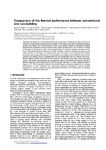Comparison of the thermal performance between conventional and cob building
| dc.contributor.author | Zeghari, K | |
| dc.contributor.author | Louahlia, H | |
| dc.contributor.author | Leguern, M | |
| dc.contributor.author | Boutouil, M | |
| dc.contributor.author | Gualous, H | |
| dc.contributor.author | Marion, M | |
| dc.contributor.author | Schaetzel, P | |
| dc.contributor.author | Goodhew, Steve | |
| dc.contributor.author | Streiff, F | |
| dc.date.accessioned | 2019-06-03T11:59:23Z | |
| dc.date.issued | 2019-08-13 | |
| dc.identifier.issn | 2555-0403 | |
| dc.identifier.issn | 2267-1242 | |
| dc.identifier.uri | http://hdl.handle.net/10026.1/14230 | |
| dc.description.abstract |
<jats:p>The appliance of sustainable development approach in building has urged construction industry to adopt proper measurements to protect environment and reduce residential building energy consumption and CO2 emissions. Thus, an increasing interest in alternative building materials has developed including the use of bio-based materials such as cob which is studied in this paper. In the previous work, many experimental and numerical studies have been carried out to characterize thermal behaviour of earth buildings, reduce its thermal conductivity and water content. In this paper, an experimental study is carried out to determine the thermal properties and energy performance of cob building. Cob samples within different soil and fiber contents are studied using an experimental set up instrumented with flux meters and micro-thermocouples in order to evaluate the local heat flux and thermal conductivity during stationary regime. The results are analysed and compared to deduce the performant mixes in terms of thermal behaviour while respecting the French thermal regulation. A static thermal simulation based on RT 2012 calculation method (the official French calculation method for the energy performance of new residential and commercial buildings according to France thermal regulation) is used to compare energy performance between conventional and cob building using the French climate data base .</jats:p> | |
| dc.format.extent | 03003-03003 | |
| dc.language.iso | en | |
| dc.publisher | EDP Sciences | |
| dc.subject | 11 Sustainable Cities and Communities | |
| dc.subject | 13 Climate Action | |
| dc.title | Comparison of the thermal performance between conventional and cob building | |
| dc.type | conference | |
| dc.type | Conference Proceeding | |
| plymouth.volume | 111 | |
| plymouth.conference-name | CLIMA, 2019 | |
| plymouth.publication-status | Published | |
| plymouth.journal | E3S Web of Conferences | |
| dc.identifier.doi | 10.1051/e3sconf/201911103003 | |
| plymouth.organisational-group | /Plymouth | |
| plymouth.organisational-group | /Plymouth/Faculty of Arts, Humanities and Business | |
| plymouth.organisational-group | /Plymouth/Faculty of Arts, Humanities and Business/School of Art, Design and Architecture | |
| plymouth.organisational-group | /Plymouth/REF 2021 Researchers by UoA | |
| plymouth.organisational-group | /Plymouth/REF 2021 Researchers by UoA/UoA13 Architecture, Built Environment and Planning | |
| plymouth.organisational-group | /Plymouth/Users by role | |
| plymouth.organisational-group | /Plymouth/Users by role/Academics | |
| dcterms.dateAccepted | 2019-05-01 | |
| dc.rights.embargodate | 2020-4-21 | |
| dc.identifier.eissn | 2267-1242 | |
| dc.rights.embargoperiod | Not known | |
| rioxxterms.versionofrecord | 10.1051/e3sconf/201911103003 | |
| rioxxterms.licenseref.uri | http://www.rioxx.net/licenses/all-rights-reserved | |
| rioxxterms.licenseref.startdate | 2019-08-13 | |
| rioxxterms.type | Conference Paper/Proceeding/Abstract | |
| plymouth.funder | CobBauge::Interreg V |


